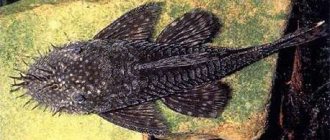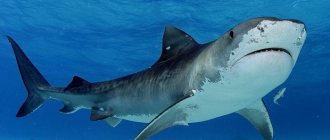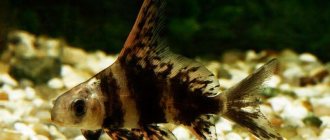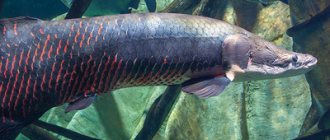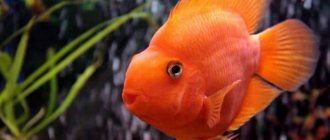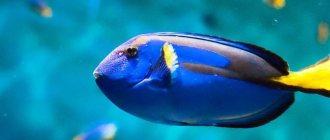Many interesting creatures live in the depths of the sea. Among them there are small harmless fish, huge ferocious predators, and there are just very “cunning” ones. These clearly include sticky fish. These resourceful creatures were able to adapt to the difficult life at sea. Instead of navigating dangerous waters on their own, they simply find themselves a shark-shaped “taxi” and ride it in the comfort of business class. What are these smart sticky fish like? And how do sharks feel about them?
Appearance
The sticky fish has a rather unusual appearance:
- Dimensions . The length of the body is 30-40 cm, but there are also individuals reaching 1 m.
- The body shape is elongated, flattened at the sides. There are bone, dense plates on the body.
- The mouth is wide.
- Fins . The anterior one has the shape of a suction cup, the dorsal and abdominal ones are large and wide.
- The color is varied, ranging from brown to blue shades. At the moment of danger, stickers are able to change their color, misleading the attacking predator.
- Distinctive feature of fish - suckers on the oral cavity, surrounded by horn-shaped scrapers. With the help of these suction cups, the fish scrapes food from the surface of stones and aquarium glass.
Sex differences
Differences between males and females can only be found in sexually mature individuals.
This period begins between 12 and 15 months of age. The male has tentacles on his head - skin outgrowths, also called antennae. Such processes in females are weakly expressed, barely noticeable or completely absent.
Fish nutrition
Stickies feed on what they get in their way. Usually these are leftovers from their neighbors' meals. If their shark catches the prey, the sticky one also gets lunch. Sometimes they themselves catch small fish. It happens that caring fellow travelers examine the skin of their neighbors and eat external parasites. Thus, they are orderlies for large marine representatives. The cunning creatures attached to the bottom of the ship eat the waste from the ship.
Keeping in an aquarium
The sticky catfish is easy to care for, but in order for it to be healthy, you will need to create the appropriate conditions:
- Tank volume . For one individual, a container of 50 liters will be enough, and for a couple – 100 liters.
- Options . The water temperature is not particularly important, but catfish are most comfortable at +17-30°C. Hardness level – from 2 to 20, acidity – from 6 to 7.5 pH.
- Water change - once a week up to ¼ of the total volume.
- Filtration and aeration . A prerequisite is the presence of a filter and an aeration system. If the catfish does not have enough oxygen, it will often rise to the surface of the water.
- The soil is pebbles of small or medium fraction.
- Plants - any, at the discretion of the aquarist.
- Lighting is moderate.
- Decoration. Driftwood and grottoes, castles and jugs should be used as decorative elements - they will serve not only as a shelter for fish that prefer to lead a secretive lifestyle. The stickers scrape food from the walls of the decorations.
Sticky is nocturnal. During daylight hours, catfish prefer to hide in shelters.
Nutrition
Sticky catfish are omnivorous and picky fish. But for their health and full development, some recommendations from experts should be taken into account:
- All types of feed are allowed - plant and animal food, frozen and industrial feed. Type of production diet - tablets and granules intended for feeding bottom fish.
- The basis of the menu is food of plant origin: cucumbers and zucchini, lettuce, pumpkin, cabbage. Pumpkin can be given semi-cooked. Other vegetables must first be scalded with boiling water.
- Feeding is carried out no more than 1 time during the day.
Compatibility
Sticky catfish are friendly and peace-loving fish that live in the bottom layers of water, where they shyly hide in grottoes or rest on the ground. Due to their non-conflict nature, Ancistrus get along well with many species of fish, however, difficulties may still arise with some phenotypes. For example, fearful and timid veiled neighbors are frightened by the active movements of aquarium catfish, so they do not coexist with such species of fish. In the same aquarium, fights or injuries are possible when ancistrus and large cichlids are adjacent; especially fierce battles occur during spawning. It is also not recommended to place catfish in the same tank with scaleless fish species.
Character
Ancistrus is a fish with a peaceful, calm disposition. Catfish can be kept in a community aquarium without any problems. Such a character trait as aggression manifests itself extremely rarely. The reason for aggressive behavior is insufficient food. In this case, the catfish can start hunting for smaller fish.
Some aggression towards neighbors during the spawning period is also possible. However, this only happens if the catfish believes that something is threatening its offspring.
Not a parasite, but a partner
Marine biologists cannot come to an opinion on what to call the relationship between the clingers and those to whom they cling.
Some people really like the term commensalism, which describes a relationship in which one side is neither hot nor cold from the existence of the other, but the other is covered in chocolate. Others believe that this is a mutually beneficial cooperation. In their opinion, by eating leftover food and feces of the “host”, the stickers purify the water around their “transport”, preventing various harmful microorganisms from developing. In addition, fishermen take on the role of a cosmetologist, carrying out regular mechanical cleaning of their partner’s powerful body, scraping off dead skin particles. “These sharks, whales, rays and the like have absolutely no way of maintaining hygiene! Yes, they would be lousy without us,” say the sticky ones, giving an interview to the Animal Planet channel, and in the meantime, sending into the mouth another parasite who dreamed of a comfortable life in the vast territory of a shark carcass.
What do the “owners” themselves think about this? Scientists have observed situations when sharks deliberately slowed down, allowing their retinue to “come on board” and begin servicing their comfortable living liner. However, there are those who are annoyed by all this partying. Thus, sand and lemon sharks firmly believe that they are not friendly with food and perceive stickers exclusively as protein bars.
Fishermen use naive clings when hunting turtles. They release the fish, having previously attached strong cords to their tails, and wait until they agree with the turtle about a joint trip. This is where the time comes to pull the string. Stuck physically cannot change her plans, and the newly-minted friends are already returning to the boat together. The carrying capacity of one fish is about 30 kg, sometimes they are released in packs and then they are able to support even green turtles weighing up to 400 kg.
Features of reproduction and spawning
For spawning to be successful, a number of conditions must be met.
Preparing for spawning. For successful reproduction, a pair of catfish must be resettled in a separate tank - a spawning tank:
- Volume – up to 50 l; soil and plants are not needed; Water must be taken from a common aquarium.
- To stimulate fish to spawn, the method of daily water change in the amount of 1/3 of the total volume is used. The temperature should be gradually reduced to +20°C.
- Long pipes or stumps must be placed in the aquarium. Only if they are present will the female lay eggs. But often females use driftwood or decorative pots to lay eggs.
- The ideal substrate for spawning is several plastic pipes. The aquarium must have a filter and aeration system running at all times.
Spawning. Signs that a couple is ready to reproduce is that the female’s abdominal volume increases. The male begins to put in order the chosen place for laying eggs. Only he takes care of the future family. As soon as the female finishes the spawning process (the number of eggs is from 30 to 100), the male drives her out of the shelter.
During the entire incubation period (up to 5 days), the male fans the eggs with his fins. This allows the eggs to have the necessary access to oxygen. In the same way, with the help of fins, the male eliminates dead eggs. This period is dangerous because if the male gets scared, he can eat the eggs in a state of stress.
Caring for the fry.
Once born, the babies remain motionless for a long time.
They feed on the remains of the yolk sac. When the food runs out, the fry are already grown enough and can be transferred to complementary feeding. Spirulina (special tablets) is used for this purpose. Some aquarists start giving crushed cucumbers right away.
Didn't stick, but stuck
Remember: if it sticks, it’s your ex-girlfriend, and the fish means it sticks. Wherever it happened, it stuck there. There are four genera and a total of eight species in this friendly family:
- ordinary sticky, also striped or large;
- whitefin stuck;
- whale stuck, also known as southern remora;
- short-finned stickfish;
- remora;
- marlin remora;
- long remora;
- white fish-stuck.
The name of the genus in Latin - Echeneidae - is formed using two words: keep and ship, remora (remora) translated from Greek means “delay”. The ancient Romans believed that, by clinging to the bottoms of ships, stickers were able to influence the speed of the ships, preventing them from demonstrating miracles of maneuverability. It was on him that they blamed the deaths of Mark Antony and Cleopatra. Like, if the fish had not sided with the enemy, having chosen the united fleet of famous lovers, the last great naval battle of antiquity could have had a completely different ending, which means that the events after it would have developed according to a different scenario.
Here educated people shuddered and imagined how many great works would not have seen the light of day. For those who have no time for Shakespeare and Massenet, we’ll explain at a glance - dozens of paintings with nudity and one incendiary porn film with Julia Taylor. Now are you ready to say “thank you” to the stickers for their contribution to world culture?
We also recommend reading:
The largest dog breeds What is domestication in animal husbandry Why you should get a cat: reasons voiced by scientists Euthanasia of animals
Diseases
Ancistrus is a fish with excellent health. But with improper care there is a risk of:
- Monkey . Manifested by the appearance of white spots on the body. The reason is the introduction of infection from the outside, for example, with poor-quality water or new fish. Treatment is by adding potassium permanganate, formalin, and copper sulfate to the water.
- Oodiniosis . Signs: decreased activity, sticking of fins, peeling of scales. Treatment for the parasite is carried out with the drug Bicillin, 1 bottle of which is diluted per 100 liters. The drug must be added three times - immediately after symptoms are detected, after 2 and 7 days.
- Chylodonellosis . The pathogen enters the aquarium with food. Signs: refusal to eat, sticking of fins or their fraying, appearance of white and blue spots. In this case, Levomycetin is prescribed.
The best prevention of diseases is the creation of appropriate conditions and proper nutrition with high-quality industrial feed.
The sticky catfish or ancistrus is an interesting and funny aquarium fish. It is absolutely easy to maintain, and watching her is a real pleasure.
The shark needs the sticky one
It’s clear why a shark or other large floating inhabitant of the sea stuck. A sticky fish, which finds it difficult to regulate its own dive, can, without particularly bothering, travel long distances, while being under serious protection. After all, practically no one attacks a shark, a whale, or a stingray.
It is not difficult to understand that tasty morsels fall from the “master’s table” to her. For example, a remora shark detaches itself as soon as its “mistress” tears apart the prey, and begins to swallow small remains. True, the stickers also hunt on their own - small fish or crustaceans. And on occasion they do not disdain zooplankton.
Sexual dimorphism of Ancistrus
Quite clear sex differences are observed in ancistrus from approximately 12-15 months of age. Females, as a rule, are larger, longer and slimmer than males, their bodies are taller, and their fins are longer and sharper.
One should especially note a detail characteristic only of males - on the head around the upper jaw there are skin growths arranged in pairs (“whiskers”), which in older individuals reach one and a half to two centimeters and even branch. In females, the processes are poorly developed throughout their lives and are almost invisible.
The male is hiding from me so that I don’t take a picture of him for the blog. How did I know, catfish
Ancistrus are superior to all herbivorous fish in their ability to eat algae; in addition, they eat the remains of animal and plant food that are not eaten by other fish. If there is a lack of algae fouling, aquarium plants can be eaten, especially tender young leaves, in which holes are successfully gnawed, and sometimes they are eaten entirely.
To avoid this, it is recommended to feed ancistrus with various plant foods. The easiest way is to use various branded foods with plant ingredients. You can also use for these purposes boiled lettuce leaves (just dip them in boiling water for one minute), cabbage or nettles, to which a weight is then tied and dropped to the bottom.
We suggest you read: What do turkeys eat? Grass for turkeys
Marine treasure maps ranks 1, 2 and 3 (T3)
From time to time you will come across treasure maps. There are several varieties of them, and they differ in their color (value). In cards of ranks 1 and 2, only yellow ones that do not have a cross on the icon are important - they always give acrasium, without any limits.
The rest can be safely thrown away, except, perhaps, for cards with a cross of orange quality. White, blue and purple will give, at best, a ship's flywheel. At the marked place on the orange map there may well be worthy treasures, for example, ammunition.
When your GS reaches 545+, rank 3 sea treasure maps will begin to appear in the Procean Sea. And under no circumstances should they be thrown away.
Yellow ones without a cross will give you a cool treasure chest, and most of these treasures are not personal.
Low quality cards can become a source of scarce materials for sharpening the T3 set.
You cannot change any sea maps from an NPC, like land maps.
Salamander
It is not only a small fire-dwelling dragon, but also (according to one dictionary) “an insectivorous frog with thick black smooth skin dotted with yellow spots.” Of these two hypostases, the legendary one is better known, so it will not surprise anyone that it is included in this book.
In Book X of Natural History, Pliny states that “the salamander is so cold that if it even touches a flame, it will immediately go out, as if a piece of ice had been placed in it”; in another place he talks about it again, skeptically noting that if what the sorcerers attribute to the salamander were true, it would be used to put out fires.
In Book XI he writes of a four-legged winged insect called the pyrralis, or pyrausta, which “lives in Cyprus in forges and copper smelters... (and flies) straight out of the fire”; and if he finds himself in the air and flies even a little, he falls dead. In human memory, the salamander became the embodiment of this now forgotten creature.
In the mid-twelfth century, a forged message was distributed throughout Europe, allegedly addressed by Protopresbyter John, King of Kings, to the Byzantine emperor. This message, which is a list of miracles, speaks of giant ants extracting gold from the earth, of a certain River of Stones, of a Sea of Sand with fish living in it, of a giant mirror reflecting everything that happens in the state, of a scepter carved from a solid emerald, about stones that make a person invisible or glow in the dark.
Remora
It is curious how the slowdown in the courts led, by association, to a delay in the trial and then to a delay in childbirth. Elsewhere, Pliny relates that the remora at Actium decided the fate of the Roman Empire by stopping the galley in which Mark Antony was reviewing his fleet, and that another remora, despite the best efforts of four hundred oarsmen, stopped Caligula's ship.
“Let the winds blow with all their might, let the showers and storms rage as fast as they can,” exclaims Pliny, “yet this little fish dominates their fury, restrains their power and shames their strength, no matter how great it is, - no matter what neither the thickest and strongest ropes, nor the heaviest and cumbersome anchors are capable of, no matter how deeply and unliftably they are anchored.”
“The greatest power does not always win. A small remora can stop a ship,” repeats the graceful Spanish writer Diego de Saavedra in his Political Emblems (1640).
Notes
- Reshetnikov Yu. S., Kotlyar A. N., Rass T. S., Shatunovsky M. I.
Five-language dictionary of animal names. Fish. Latin, Russian, English, German, French. / under the general editorship of academician. V. E. Sokolova. - M.: Rus. lang., 1989. - P. 310. - 12,500 copies. — ISBN 5-200-00237-0. - Wheeler A.
Sem. Adherents - Echeneidae // Key to the fishes of marine and fresh waters of the North European Basin = Key to the Fishes of Northern Europe / Translation from English by T. I. Smolyanova, edited by Ph.D. biol. Sciences V. P. Serebryakova. - M.: Light and food industry, 1983. - 432 p. - Biological encyclopedic dictionary / Ch. ed. M. S. Gilyarov; Editorial team: A. A. Baev, G. G. Vinberg, G. A. Zavarzin and others - M.: Sov. encyclopedia, 1986. - P. 505. - 831 p. — 100,000 copies.
- Glotov Yu. G., Semchenko V. A.
Popular maritime encyclopedia. - Phoenix, 2001. - 512 p. ISBN 5-85880-349-0 - Akimushkin I. I.
Animal world. Stories about snakes, snakes, turtles, frogs, fish / Ed. L. Antonyuk. - M.: Young Guard, 1974. - P. 43.
Original: Original:
What are the options?
There are many varieties of sticky cleaners and each of them is individual. Many species are unique and inimitable. Among them:
Hypancistrus zebra Hypancistrus zebra is a species unique in color. Having an almost exotic appearance, he is simple in maintenance and kind in character. A quiet life is his habit. Prefers almost twilight, a lot of green and strong plants, clean water, preferably heated to 30-31o;
Ancistrus diamondis Ancistrus diamondis - a velvety black lump with bright dots, shimmering in a variety of diamond colors - a truly rare exclusive in the world of fish fashion;
Ancistrus super red Ancistrus super red is one of the young species imported from Germany. The fish are bright orange in color, with transparent fins, which are framed along the contour by a bright red stripe. They differ from ordinary catfish only in color and, perhaps, in smaller sizes;
Ancistrus albino Ancistrus albino is a very gentle and unusual creature
Having a white or golden color and thanks to its wide fins, this Ancistrus fish looks like soft fluff that smoothly moves along the bottom, attracting everyone's attention.
But Ancistrus claro differs little from the usual Ancistrus in appearance, but is more inclined to change its natural reflexes depending on the environment. Thus, ancistrus easily replace their night life with day life, and their reclusive nature is diluted with interest in the world around them, including outside the walls of the aquarium.


